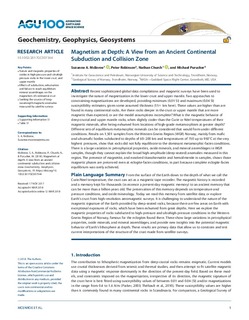| dc.contributor.author | McEnroe, Suzanne | |
| dc.contributor.author | Robinson, Peter | |
| dc.contributor.author | Church, Nathan Stewart | |
| dc.contributor.author | Purucker, Micheal | |
| dc.date.accessioned | 2018-12-18T13:02:28Z | |
| dc.date.available | 2018-12-18T13:02:28Z | |
| dc.date.created | 2018-03-04T17:06:40Z | |
| dc.date.issued | 2018 | |
| dc.identifier.citation | Geochemistry Geophysics Geosystems. 2018, 19 (4), 1123-1147. | nb_NO |
| dc.identifier.issn | 1525-2027 | |
| dc.identifier.uri | http://hdl.handle.net/11250/2578101 | |
| dc.description.abstract | Recent sophisticated global data compilations and magnetic surveys have been used to investigate the nature of magnetization in the lower crust and upper mantle. Two approaches to constraining magnetizations are developed, providing minimum (0.01 SI) and maximum (0.04 SI) susceptibility estimates, given some assumed thickness (15+ km here). These values are higher than are found in many continental rocks. Are there rocks deeper in the crust or upper mantle that are more magnetic than expected, or are the model assumptions incomplete? What is the magnetic behavior of deep‐crustal and upper mantle rocks, when slightly cooler than the Curie or Néel temperatures of their magnetic minerals, after being exhumed from locations of high‐grade metamorphism at greater depth? Different sets of equilibrium metamorphic minerals can be considered that would form under different conditions. Results on 1,501 samples from the Western Gneiss Region (WGR) Norway, mainly from mafic and ultramafic bodies subducted to depths of 60–200 km and temperatures of 750 up to 950°C at the very highest pressures, show that rocks did not fully equilibrate to the dominant metamorphic‐facies conditions. There is a large variation in petrophysical properties, oxide minerals, and mineral assemblages in WGR samples, though they cannot explain the broad high‐amplitude (deep‐seated) anomalies measured in this region. The presence of magnetite, and exsolved titanohematite and hemoilmenite in samples, shows those magnetic phases are preserved even at eclogite‐facies conditions, in part because complete eclogite‐facies equilibrium was rarely achieved. | nb_NO |
| dc.language.iso | eng | nb_NO |
| dc.publisher | American Geophysical Union (AGU) | nb_NO |
| dc.rights | Attribution-NonCommercial-NoDerivatives 4.0 Internasjonal | * |
| dc.rights.uri | http://creativecommons.org/licenses/by-nc-nd/4.0/deed.no | * |
| dc.title | Magnetism at Depth: A View from an Ancient Continental Subduction and Collision Zone | nb_NO |
| dc.type | Journal article | nb_NO |
| dc.type | Peer reviewed | nb_NO |
| dc.description.version | publishedVersion | nb_NO |
| dc.source.pagenumber | 1123-1147 | nb_NO |
| dc.source.volume | 19 | nb_NO |
| dc.source.journal | Geochemistry Geophysics Geosystems | nb_NO |
| dc.source.issue | 4 | nb_NO |
| dc.identifier.doi | 10.1002/2017GC007344 | |
| dc.identifier.cristin | 1570309 | |
| dc.relation.project | Norges forskningsråd: 222666 | nb_NO |
| dc.description.localcode | © 2018. The Authors. This is an open access article under the terms of the Creative Commons Attribution‐NonCommercial‐NoDerivs License. | nb_NO |
| cristin.unitcode | 194,64,90,0 | |
| cristin.unitname | Institutt for geovitenskap og petroleum | |
| cristin.ispublished | true | |
| cristin.fulltext | original | |
| cristin.qualitycode | 2 | |

